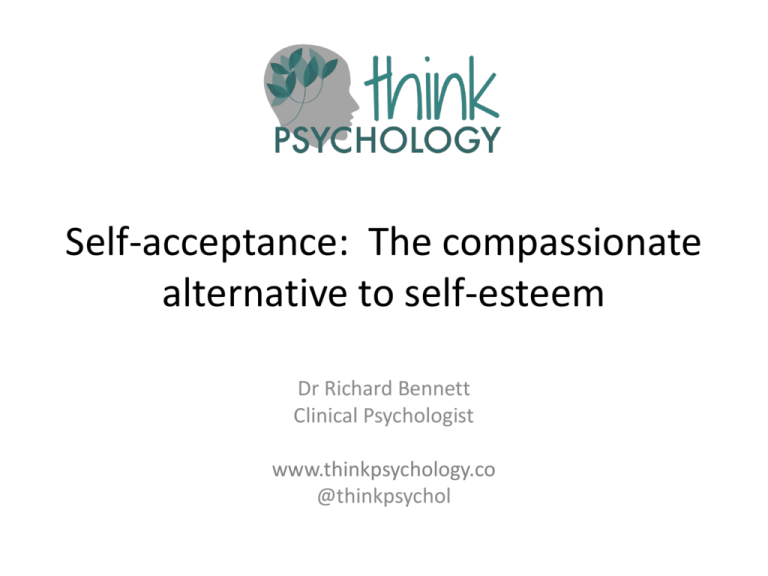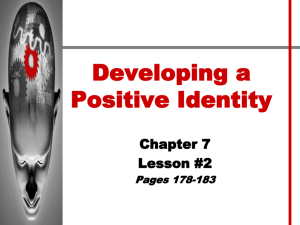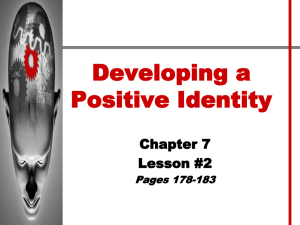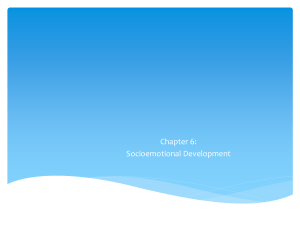Overcoming Low Self Esteem - Association for Contextual
advertisement

Self-acceptance: The compassionate alternative to self-esteem Dr Richard Bennett Clinical Psychologist www.thinkpsychology.co @thinkpsychol Overview • Self-acceptance and self-esteem – Defining concepts – Relationship to ACT and RFT theory – Useful strategies for promoting a dialogue based around self-acceptance Without whom… • Steven Hayes, Kirk Strosahl, Kelly Wilson, Yvonne Barnes-Holmes, Dermot BarnesHolmes, Louise McHugh, Mairead Foody, Russ Harris, Albert Ellis, Windy Dryden, Niklas Torneke, Rikke Kjelgaard, Peter Trower, Jason Jones • The entire ACBS community Defining the self • ‘The self’ lacks operational definition • RFT offers a developmental account of the self via learning ‘deictic’ or ‘perspective’ relations – I v You – Here v There – Now v Then • Over time, a consistent and distinct sense of ‘I-ness’ is developed in relation to other perspectives McHugh L, Barnes-Holmes Y, Barnes-Holmes D (2004) Perspective-taking as relational responding: a developmental profile. Psychol Rec, 54:115-144. Defining the self • ‘I-here-now’ coherence is crucial as we mature, but… • …”Good development gets you into bad trouble” (Yvonne Barnes-Holmes) • Development supports fusion – excessive co-ordination between ‘I-ness’ and content – tendency to co-ordinate judgements along a single dimension – high regulation of behavioural functions as a consequence DeSoto, C.B (1961). The Predilection for Single Orderings. Journal of Abnormal and Social Psychology, 62, 16-23 McHugh L, Stewart I (2012). The Self and Perspective Taking: Contributions and Applications From Modern Behavioral Science. Dublin: New Harbinger Publications Defining self-esteem • The concept of self-esteem has two components: – Self • The summation of your (verbal) history • All behaviours / emotions / sensations / thoughts / fantasies / physiology / characteristics / traits / talents / skills / dreams – The ‘self’ is extremely complex – The ‘self’ is constantly changing Defining self-esteem • The concept of self-esteem has two components: – Esteem • From the verb ‘estimate’ • Synonyms: judge / rate / evaluate – Consider • Why are people esteemed? • How do they become esteemed? Defining self-esteem • A learned, global judgment about the self…which shapes how the person thinks, feels and behaves on a day-to-day basis • The overall opinion we have of ourselves, how we judge or evaluate ourselves, the value we attach to ourselves as people • It is a generic cognitive representation of the self (a schema), based on perception and experience that is: – Learned – Self-maintaining – Resistant to change – An influence on information processing and behavioural responses Fennell, M. (1999). Overcoming Low Self Esteem. Edinburgh: Constable & Robinson. CONCEPTUALISED SELF The language of low self-esteem • “I can’t cope. I’m worthless” • “I failed. I always fail. I’m a failure” • “She left me. I know I’m unloveable” Hierachical deictic relations I-ness Content Conten t I-ness ✓ Foody, M, Barnes-Holmes, Y & Barnes-Holmes, D. (2013). An Empirical Investigation of Hierachical versus Distinction Relations in a Self-based ACT exercise. International Journal of Psychology and Psychological Therapy, 13, 3, 373-388 ✗ Is high self-esteem the remedy? • Low self-esteem involves consistently giving ones’ complex and changing ‘self’ a single, global, negative rating. • High self-esteem involves consistently giving ones’ complex and changing ‘self’ a single, global, positive rating. • Is that the answer? • Take a piece of A4 paper… The rating game (good) Self (bad) (good) (bad) Action / Effect / Characteristic Wessler, RA & Wessler, RL (1980). The Principles and Practice of Rational-Emotive Therapy, Jossey-Bass A predilection for single orderings (good) (good) Self Action / Effect / Characteristic (bad) (bad) Wessler, RA & Wessler, RL (1980). The Principles and Practice of Rational-Emotive Therapy, Jossey-Bass Overcoming the rating game • Rate a chair Overcoming the rating game • You can rate its characteristics • You cannot rate its essence • Are humans more complex than chairs? Why is self-esteem problematic? • Self-esteem involves two ratings when one will suffice – “Doing better at my work is a better thing and therefore I am a better person” – The second part is not necessary and represents a logical error • The whole-part error – It involves conceptualising the self on the basis of content • The pizza metaphor Why is self-esteem problematic? • Humans are of equal worth irrespective of what they have achieved or done, or what is happening around them – Is my worth as a person enhanced if I perform well at something? – Is my worth as a person diminished if I perform badly at something? – Would you raise a child to believe this? • E.g. child does a good act and you say “Good Boy!” or behaves badly and you say “Bad boy!!!” – What would be the impact upon them if you did? Why is self-esteem problematic? • It denies our complexity – You can sample the self but global ratings are not helpful – Such ratings tend to exert control over behavioural functions and limit our repertoire • Esteem ratings are conditional – Conditional high self-esteem is fleeting • ‘Improving’ self-esteem often reduces motivation to change – It can externalise control and responsibility Working to raise self-esteem promotes the swapping of one conceptualised self for another This is not consistent with ACT Hayes, S., Strosahl, K, Wilson, K. (1999) Acceptance and Commitment Therapy. New York: Guilford Press It’s the context that counts Marshall et al (2015) Self-compassion protects against the negative effects of low self-esteem: A longitudinal study in a large adolescent sample. Journal of Personality and Individual Differences, 74, 116-121 Key therapeutic targets • Weakening fusion with self-criticism and selfconceptualisations • Strengthening deictic framing repertoires involved in cultivating self-perspective-taking and self-as-context • Constructing and enacting a value of selfcompassion through self-acceptance Yadavaia et al (2014) Using ACT to increase self-compassion: a randomized controlled trial. Journal of Contextual Behavioral Science, 3, 248-257 Unconditional self-acceptance • An alternative to the concept of self-esteem • Initially promoted by Albert Ellis as a key feature of Rational Emotive Behaviour Therapy (REBT) • A resurgent idea in third wave cognitive behavioural therapies Ellis, A. (2005) The Myth of Self-esteem. New York: Prometheus Books Unconditional self-acceptance • Promoting unconditional self-acceptance – Human beings are too complex to give a single rating – In our essence, we are • Un-rateable, although it may be workable for us to rate aspects of ourselves in order to take credit for positive qualities or address less desirable ones. • In flux – ever changing • Fallible – incurable tendency to make mistakes • Unique – just like everyone else! • Equal to others in terms of a shared humanity but unequal in specific ways “You love a person because he or she has lovable traits, but you accept everybody just because they’re alive and human” Albert Ellis Unconditional self-acceptance • Promoting unconditional self-acceptance – All around the world people have a shared sense of ‘human-ness’- we are all composed of good / bad / indifferent qualities – We all have the same intrinsic worth – We are not defined by our behaviours • Doing a bad thing does not make one a bad person • Doing a good thing does not make one a good person Dryden, W. (1999) How to Accept Yourself. London: Sheldon Press Unconditional self-acceptance • Unconditional self-acceptance encourages a person to notice aspects of their experience but discourages someone from assigning a global negative self-rating… – …whereas self-esteem encourages the person to rate their whole ‘self’ • Unconditional self-acceptance encourages a person to take a broad perspective on aspects of their self… – …whereas self-esteem influences people to see the self in a limited context • Unconditional self-acceptance promotes flexible perspective taking and avoids over-general conceptualisation – …whereas self-esteem leads people toward rigidity and fusion with a conceptualised self NB…a logical extension Self Acceptance Other Life Let’s get real… • Unconditional self acceptance can be learnt (but not practiced perfectly or all of the time) • Internalizing it is difficult and involves hard work • So, where to start? “Have the life you want by being present to the life you have” Mark Nepo A compassionate stance via RFT Therapist Content Client Content McHugh, L & Stewart, I. (2012) The Self and Perspective Taking. Oakland: New Harbinger A compassionate stance via RFT • Promote self-other co-ordination through perspective taking (“If I were you…”) – Validate the presence of the content – Validate the emotional impact of the content – Validate the behavioural control exerted by the content • Source: Yvonne Barnes-Holmes (2015) A compassionate stance via RFT • Promote self-content distinction – Observe the content – Discriminate between self and content – Present opportunity to choose • E.g. to make choices that are not about you being governed by your content Verbal strategies for promoting self acceptance • Discouraging global conceptualisations – Noticing the difference between context and content • • • • • • The sky and the weather (Russ Harris) The chessboard metaphor (Hayes, Strosahl, Wilson) The pizza metaphor (Jason Jones) Rating a chair (Peter Trower) The fruit bowl metaphor (Ruth and Richard Wessler) “Big I, Little i” technique (Arnold Lazarus) iiiiiiiiiiiiiiiiiiiiiiiiiiiiiiiiiiiii iiiiiiiiiiiiiiiiiiiiiiiiiiiiiiiiiiiii iiiiiiiiiiiiiiiiiiiiiiiiiiiiiiiiiiiii iiiiiiiiiiiiiiiiiiiiiiiiiiiiiiiiiiiii iiiiiiiiiiiiiiiiiiiiiiiiiiiiiiiiiiiii iiiiiiiiiiiiiiiiiiiiiiiiiiiiiiiiiiiii iiiiiiiiiiiiiiiiiiiiiiiiiiiiiiiiiiiii iiiiiiiiiiiiiiiiiiiiiiiiiiiiiiiiiiiii iiiiiiiiiiiiiiiiiiiiiiiiiiiiiiiiiiiii iiiiiiiiiiiiiiiiiiiiiiiiiiiiiiiiiiiii iiiiiiiiiiiiiiiiiiiiiiiiiiiiiiiiiiiii iiiiiiiiiiiiiiiiiiiiiiiiiiiiiiiiiiiii iiiiiiiiiiiiiiiiiiiiiiiiiiiiiiiiiiiii iiiiiiiiiiiiiiiiiiiiiiiiiiiiiiiiiiiii iiiiiiiiiiiiiiiiiiiiiiiiiiiiiiiiiiiii iiiiiiiiiiiiiiiiiiiiiiiiiiiiiiiiiiiii iiiiiiiiiiiiiiiiiiiiiiiiiiiiiiiiiiiii iiiiiiiiiiiiiiiiiiiiiiiiiiiiiiiiiiiii iiiiiiiiiiiiiiiiiiiiiiiiiiiiiiiiiiiii Video demonstration – “I am selfish” • Watch the clip, which incorporates: – The sky and the weather metaphor – A mindfulness process based on hierarchical deictic relations • Notice and reflect upon: – The verbal content of the session – The relational process between therapist and client Self-acceptance: The compassionate alternative to self-esteem Dr Richard Bennett Clinical Psychologist www.thinkpsychology.co @thinkpsychol





